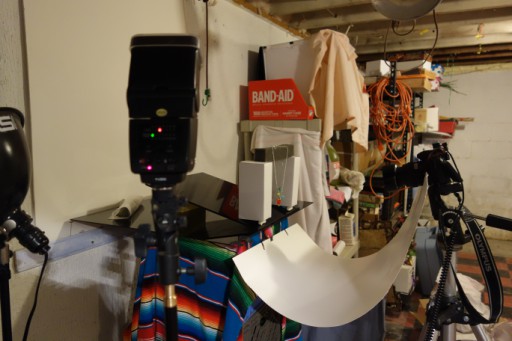This is mostly refinements on my previous post. My extremely jury-rigged setup of cardboard boxes and old electronics foam had a tendency to fall over when I hung (relatively speaking) heavy jewelry from it, so I put some aluminum disks in the boxes to weight them, and actively pinned the foam to the boxes (in the edge, where the holes wouldn't show.)
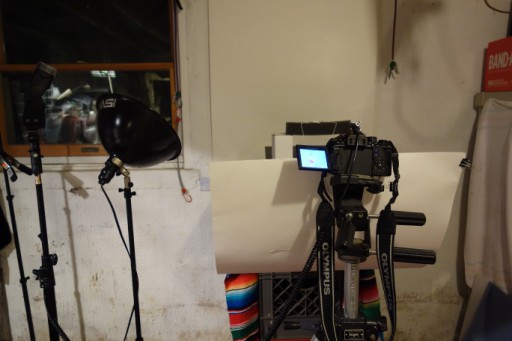
Flash is on its default settings—slave off, full power, 35mm focus. Oh, wait, that plastic diffuser that came with the flash is on it too.
I also put prodigious amounts of handy-tac under the boxes to level them, and supported the dark grey (it looks black) plastic on an empty cardboard tea box, the kind that holds 20 teabags. We literally have dozens of these things lying around.[1]
I've lit the scene with a photoflood, because I can't trigger the flash with the sony I shot this scene with. It's a good little shirt-pocket, with many dslr features (full manual overrides, frex) but it doesn't have a jack or hotshoe to trigger flash:)
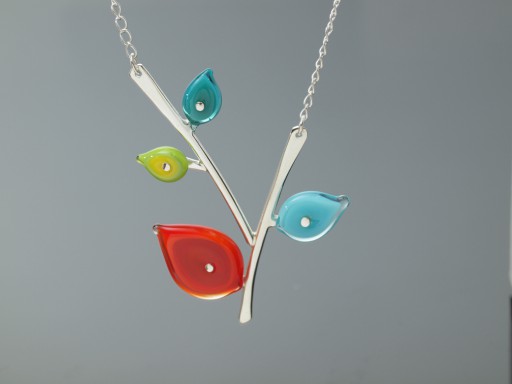
And here's the necklace in the previous shot. This particular exposure is f6.3; I shot most of these at 5.6, 6.3, 7.1 and f8, at a 1/4sec with the flash at full, focused at 35mm, and pointed diagonally at the ceiling.
Amusingly enough, my camera's metadata claims the flash “did not fire” which is what happens, I guess, when you hook a manual flash[2] up via two cords and a hotshoe... But at least I've gotten a proper lightstand & mount for the flash, so no more bungee cord!
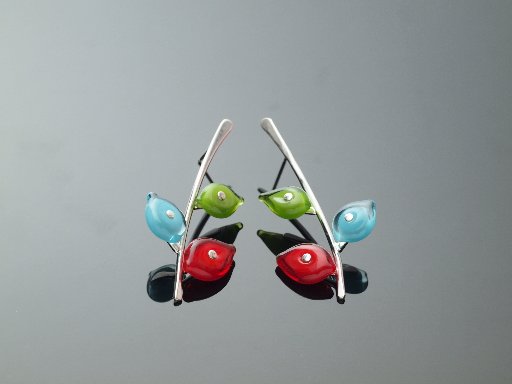
Earrings, from the same shoot, but lit with a 500w photoflood. 1/10sec, out of 1/13, 1/10, 1/8, all at f8.
Besides the excitement of having the flash images (i.e. the hanging necklaces) work pretty much right out of the gate[3] it finally dawned on me that the reason the silver is burning out[4] in the photoflood images is because the camera is reacting differentially to the highlights and midtones. See, I filter the light pretty intensely to avoid specular highlights, and also to avoid the dreaded clipping on the silver (itself a form of specular highlight). But no matter how much I diffuse the light, in order to get the rest of the piece properly exposed the shiny silver becomes overexposed—but not when I use flash.
Why? For the same reason, I suspect, that in the old film days, if you took very long exposures, the blue emulsion would respond differently than the other two. Which threw the color balance off. Evidently, at low exposures, the detector responds more strongly to the the brightest areas, blowing them out. Which means, I guess, that I need to learn how to shoot all my stuff with flash.
Also, the image doesn't show the packing foam/tissue I used to diffuse tiny specular highlights that showed up in the earlier images. You can see them on the green and yellow leaf above, or click on the image for full-res, where they'll be obvious.
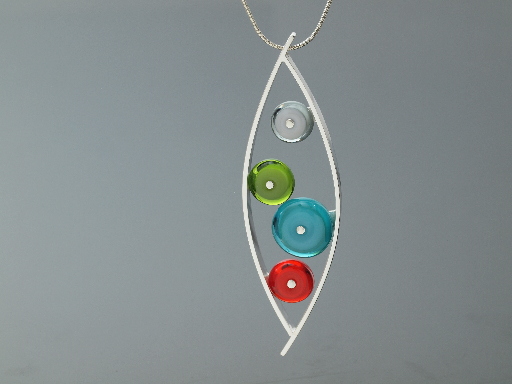
This necklace, later in the series, was more successfully “diffused”. f7.1, (6.3, 7.1, 8) 1/4sec flash full focused at 35mm. The jaggies (artifacts) in this image are a result of the downsizing algorithm, not the quality of the photo.
These are not perfect photos, but considering that I shot 13 necklaces in an hour (admittedly very similar in style, and of an artist's work with which I'm very familiar) I think they're pretty decent. Of course, as always, it really helps that the subjects are so beautiful.
Unless otherwise noted, text, image and objects depicted therein copyright 1996--present sylvus tarn.
Sylvus Tarn